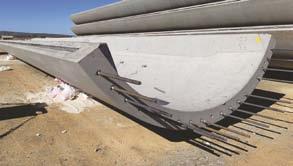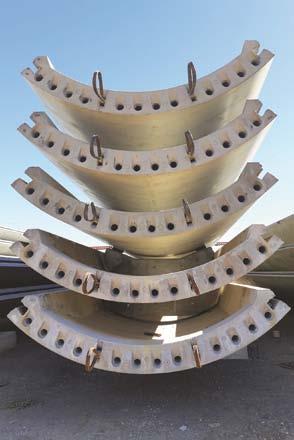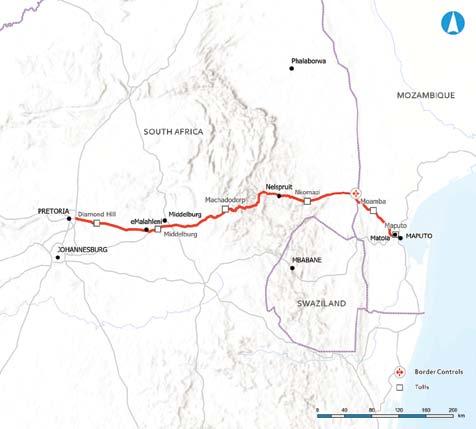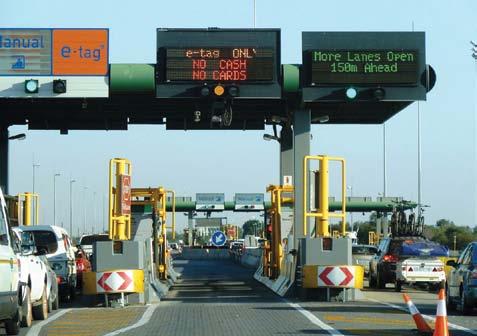
5 minute read
Increasing the life of concrete for sustainable built environments
the power of wind –
Bringing in the reinforcements
Advertisement
The manufacture of concrete wind turbine towers requires production speed and segment uniformity. Strengthening the precast concrete segments for these towers across wind farms all over South Africa’s Eastern Cape and Western Cape provinces is vital to the sector. the average concrete turbine tower comprises 18 precast segments, each with a height of between 18 to 20 metres and a diameter of between 600 mm and two metres. In the manufacture of these precast elements, the production speed and segment uniformity are essential. this demands high early strengths to ensure fast erection, while giving the towers an ability to withstand demanding fatigue loads. Wind turbines must also be able to perform in some of the country’s harshest working environments, making durability a key requirement for the concrete mixes used in precast units.
STRONg ENOugh TO hOlD uP AT 100 METRES
In wind farms all over South Africa’s Eastern Cape and Western Cape provinces, ChrySo Southern Africa is adding value to the precast concrete segments used to construct the 100 metre tall wind turbine towers. the range of plasticisers facilitates workability retention of between 30 and 45 minutes while achieving high early strengths. these early strengths allow for the fast erection of the towers owing to the quick turnaround time as the mould release and pre-stressing release can be done earlier. the plasticisers optimise early and late age strength development in concrete mixes. these plasticisers maintain consistency in the manufacturing of reinforced concrete components, reducing the sensitivity of concrete to variations in water content.
DECREASED PERMEABIlITy AND ShRINKAgE
plastic shrinkage cracking and plastic settlement cracking can occasionally penetrate deep into a precast unit, causing significant cost in remedial measures and even replacement. Applying a curing compound from the ChrySo® Cure range to the precast segments reduces the incidence of shrinkage cracks and promotes better strength gain characteristics. Curing compounds also increase the impermeability of concrete, making it more durable.
Another important product gaining traction in this market is a.b.e.® duragrout. developed especially for wind farm precast applications, this product which is proving popular is being used to level segment holders. the duragrout WF product is used for grouting and bedding of structural elements; it can be pumpable or gravity fed and has good cohesive properties without bleed or segregation. It is pre-blended and ready-touse, requiring only clean water to be added.
In a related development, ChrySo has partnered with Maturix to develop an innovative sensor solution with a digital cloud platform to monitor the maturity of concrete. It has been used worldwide on more than 350 in-situ and precast projects, and is being trialled on a wind farm project in South Africa. this cloud-based solution helps the construction industry to monitor concrete curing and hardening through hydration temperature measurements. n

CHRYSO Southern Africa is adding value to the precast concrete segments used to construct the 100 metre tall wind turbine towers
Applying a curing compound from the CHRYSO® Cure Range to the precast segments reduces the incidence of shrinkage cracks The CHRYSO® Fluid Premia range maintains consistency in the manufacturing of reinforced concrete components


unlocking the value of mozambique’s transport infrastructure
Although unlocking mineral resources underlies much of the developing transport infrastructure in Africa, the projects jointly developed between Mozambique and South Africa have intentionally stimulated investment in shared infrastructure as part of developing diversified capabilities and industrialization is a critical developmental goal. this includes backwards linkages into supplier industries and services. the initiatives identify major infrastructure investments made to serve a key industry or user and design them in such a way that they can be more widely accessed.
the World bank’s Southern Africa trade and Connectivity project will improve trade infrastructure across the Nacala Corridor in Mozambique, Malawi and Zambia.

the Nacala Corridor is a logistic highway that links four Mozambique provinces (Nampula, Niassa, Cabo delgado and tete) and two neighbouring countries (Malawi and Zambia). the Mozambican government envisions this corridor will provide fast, competitive infrastructure for trade and commerce, such as modernized borders, rail and roads connecting all major industrial centres and, finally the port of Nacala. this corridor reaches over 40 million people. the World bank is developing the Southern Africa trade and Connectivity project that will essentially improve trade infrastructure across the Nacala Corridor in Mozambique, Malawi and Zambia. this project will significantly improve the market conditions for international companies doing business in these countries. the World bank Southern Africa trade and Connectivity project focuses on four areas: 1. Reduce trade costs: Improve trade facilitation and regulatory capacity along the corridor. Enabling digital trade
through the development of trade ICt systems, as well as improving transparency 2. Strengthen regional coordination: Enhance regional coordination and strengthen regional institutions. Support for the expansion and rehabilitation of border posts 3. Increase investment in value chains: Increase productivity, reliability, and enhance quality through an integrated value chain approach, working conjointly with producers who will utilize the corridor 4. Improve road connectivity: Fill gaps in key corridor roads or connectors to economic centers. Improving road projects valued at $ 115m in Mozambique alone.

PROJECT hIghlIghTS
the N4 toll route is a brownfield toll road concession of 630 km running from pretoria to Maputo, the capital of Mozambique and a deep-sea port on the Indian ocean. the project was structured as a public-private partnership (ppp) between the governments of South Africa and Mozambique and a private consortium for a 30-year period. It was the first cross-border transport ppp project in Sub-Saharan Africa and the first brownfield ppp of this scale in South Africa.
the N4 is one of the most important trade routes in the region, running across South Africa from botswana to Mozambique. It runs through some of the most industrialised areas in South Africa, including processing, mining and smelting industries located in the cities of Johannesburg and pretoria. Moreover, the western section of the N4 forms part of the trans-kalahari Corridor, a road network spanning approximately 1900 km across South Africa, botswana and Namibia. the corridor starts in pretoria and goes to the port of







